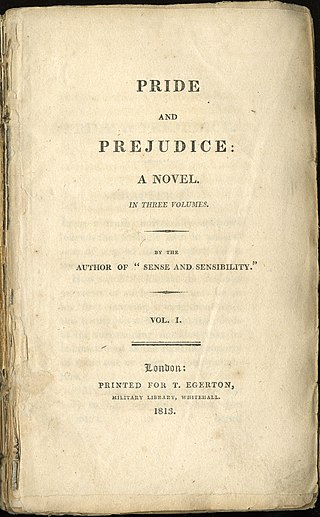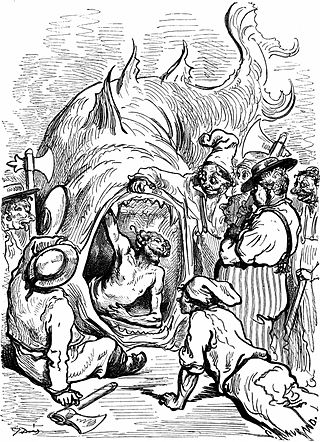Related Research Articles

Jane Austen was an English novelist known primarily for her six novels, which implicitly interpret, critique, and comment upon the British landed gentry at the end of the 18th century. Austen's plots often explore the dependence of women on marriage for the pursuit of favourable social standing and economic security. Her works are an implicit critique of the novels of sensibility of the second half of the 18th century and are part of the transition to 19th-century literary realism. Her deft use of social commentary, realism and biting irony have earned her acclaim among critics and scholars.

Pride and Prejudice is the second novel by English author Jane Austen, published in 1813. A novel of manners, it follows the character development of Elizabeth Bennet, the protagonist of the book, who learns about the repercussions of hasty judgments and comes to appreciate the difference between superficial goodness and actual goodness.

Sense and Sensibility is the first novel by the English author Jane Austen, published in 1811. It was published anonymously; By A Lady appears on the title page where the author's name might have been. It tells the story of the Dashwood sisters, Elinor and Marianne as they come of age. They have an older half-brother, John, and a younger sister, Margaret.

Emma is a novel written by English author Jane Austen. It is set in the fictional country village of Highbury and the surrounding estates of Hartfield, Randalls and Donwell Abbey, and involves the relationships among people from a small number of families. The novel was first published in December 1815, although the title page is dated 1816. As in her other novels, Austen explores the concerns and difficulties of genteel women living in Georgian–Regency England. Emma is a comedy of manners.
A first-person narrative is a mode of storytelling in which a storyteller recounts events from that storyteller's own personal point of view, using first-person grammar such as "I", "me", "my", and "myself". It must be narrated by a first-person character, such as a protagonist, re-teller, witness, or peripheral character. Alternatively, in a visual storytelling medium, the first-person perspective is a graphical perspective rendered through a character's visual field, so the camera is "seeing" out of a character's eyes.
In literary criticism, stream of consciousness is a narrative mode or method that attempts "to depict the multitudinous thoughts and feelings which pass through the mind" of a narrator.

A narrative, story, or tale is any account of a series of related events or experiences, whether nonfictional or fictional. Narratives can be presented through a sequence of written or spoken words, through still or moving images, or through any combination of these. The word derives from the Latin verb narrare, which is derived from the adjective gnarus. The formal and literary process of constructing a narrative—narration—is one of the four traditional rhetorical modes of discourse, along with argumentation, description, and exposition. This is a somewhat distinct usage from narration in the narrower sense of a commentary used to convey a story. Many additional narrative techniques, particularly literary ones, are used to build and enhance any given story.
Metafiction is a form of fiction that emphasizes its own narrative structure in a way that inherently reminds the audience that they are reading or viewing a fictional work. Metafiction is self-conscious about language, literary form, and story-telling, and works of metafiction directly or indirectly draw attention to their status as artifacts. Metafiction is frequently used as a form of parody or a tool to undermine literary conventions and explore the relationship between literature and reality, life, and art.

Persuasion is the last novel completed by the English author Jane Austen. It was published on 20 December 1817, along with Northanger Abbey, six months after her death, although the title page is dated 1818.

An unreliable narrator is a narrator whose credibility is compromised. They can be found in fiction and film, and range from children to mature characters. The term was coined in 1961 by Wayne C. Booth in The Rhetoric of Fiction. While unreliable narrators are almost by definition first-person narrators, arguments have been made for the existence of unreliable second- and third-person narrators, especially within the context of film and television, and sometimes also in literature.
Narration is the use of a written or spoken commentary to convey a story to an audience. Narration is conveyed by a narrator: a specific person, or unspecified literary voice, developed by the creator of the story to deliver information to the audience, particularly about the plot: the series of events. Narration is a required element of all written stories, presenting the story in its entirety. It is optional in most other storytelling formats, such as films, plays, television shows and video games, in which the story can be conveyed through other means, like dialogue between characters or visual action.

Gérard Genette was a French literary theorist, associated in particular with the structuralist movement and with figures such as Roland Barthes and Claude Lévi-Strauss, from whom he adapted the concept of bricolage.
Fiction writing is the composition of non-factual prose texts. Fictional writing often is produced as a story meant to entertain or convey an author's point of view. The result of this may be a short story, novel, novella, screenplay, or drama, which are all types of fictional writing styles. Different types of authors practice fictional writing, including novelists, playwrights, short story writers, radio dramatists and screenwriters.

Elinor Dashwood is a fictional character and the protagonist of Jane Austen's 1811 novel Sense and Sensibility.

The Art of Fiction is a book of literary criticism by the British academic and novelist David Lodge. The chapters of the book first appeared in 1991-1992 as weekly columns in The Independent on Sunday and were eventually gathered into book form and published in 1992. The essays as they appear in the book have in many cases been expanded from their original format.

The reception history of Jane Austen follows a path from modest fame to wild popularity. Jane Austen (1775–1817), the author of such works as Pride and Prejudice (1813) and Emma (1815), has become one of the best-known and most widely read novelists in the English language. Her novels are the subject of intense scholarly study and the centre of a diverse fan culture.

The author Jane Austen and her works have been represented in popular culture in a variety of forms.
Characterization or characterisation is the representation of characters in narrative and dramatic works. The term character development is sometimes used as a synonym. This representation may include direct methods like the attribution of qualities in description or commentary, and indirect methods inviting readers to infer qualities from characters' actions, dialogue, or appearance. Such a personage is called a character. Character is a literary element.
Jane Austen's (1775–1817) distinctive literary style relies on a combination of parody, burlesque, irony, free indirect speech and a degree of realism. She uses parody and burlesque for comic effect and to critique the portrayal of women in 18th-century sentimental and Gothic novels. Austen extends her critique by highlighting social hypocrisy through irony; she often creates an ironic tone through free indirect speech in which the thoughts and words of the characters mix with the voice of the narrator. The degree to which critics believe Austen's characters have psychological depth informs their views regarding her realism. While some scholars argue that Austen falls into a tradition of realism because of her finely executed portrayal of individual characters and her emphasis on "the everyday", others contend that her characters lack a depth of feeling compared with earlier works, and that this, combined with Austen's polemical tone, places her outside the realist tradition.
Uncle Charles Principle, according to Canadian literary critic Hugh Kenner, is a narrative procedure used by Irish writer James Joyce in several of his books. In his study Joyce's Voices, Kenner analyzes in depth the use of this technique throughout the novel Ulysses. Joyce uses the "Uncle Charles Principle" to represent two roles in the novel, that of its protagonist, Leopold Bloom, and that of the classic literary narrator. The procedure, however, receives his name from a character from another Joyce's novel: A Portrait of the Artist as a Young Man. Joyce acknowledged having beem inspired by the work Les Lauriers Sont Coupés by the French writer Édouard Dujardin.
References
- 1 2 Randell Stevenson, Modernist Fiction: An Introduction, p.32.
- 1 2 3 4 5 6 Keymer, Tom (2020). Jane Austen: Writing, Society, Politics (First ed.). Oxford University Press. pp. 82–87. ISBN 978-0-19-886190-4 . Retrieved October 5, 2021.
- 1 2 Roy Pascal, "The Dual Voice", Manchester University Press, 1977, page 34
- ↑ Modernistic Fiction: An Introduction. Lexington: University of Kentucky, 1992, p.12.
- ↑ Mandel, Anthony. "Language". Jane Austen In Context. Ed. Janet Todd. Cambridge: Cambridge University Press, 2005. 30–31. ISBN 0-521-82644-6.
- ↑ Page, Norman. The Language of Jane Austen. Oxford: Blackwell, 1972. p.121. ISBN 0-631-08280-8.
- ↑ Butler, Marilyn. Jane Austen and the War of Ideas. 1975 and 1987. Oxford: Oxford University Press, 2002. pp. 189-190. ISBN 0-19-812968-8.
- ↑ Page, Norman. The Language of Jane Austen. Oxford: Blackwell, 1972. Qtd in Page, 122. ISBN 0-631-08280-8.
- ↑ Page, Norman. The Language of Jane Austen. Oxford: Blackwell, 1972. p.122. ISBN 0-631-08280-8.
- ↑ Lynch, Deidre. The Economy of Character. Chicago: University of Chicago Press, 1998. p.237. ISBN 0-226-49820-4.
- ↑ Page, Norman. The Language of Jane Austen. Oxford: Blackwell, 1972. p.134. ISBN 0-631-08280-8.
- ↑ Hurston, Zora Neale (2006). Their Eyes Were Watching God. USA: Amistad, imprint of Harper Perennial Modern Classics. p. 203. ISBN 0-06-093141-8.
- ↑ Modernistic Fiction: An Introduction, p.32.
- ↑ Rzepka, Charles (2013). Being Cool: The Work of Elmore Leonard . Baltimore: Johns Hopkins University Press. p. 21. ISBN 9781421410159.
- ↑ E.g. Helen Phillips, An introduction to the Canterbury tales , Palgrave Macmillan, 2000